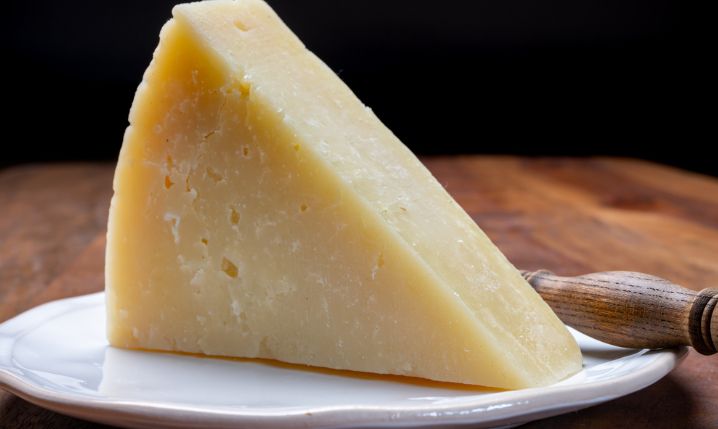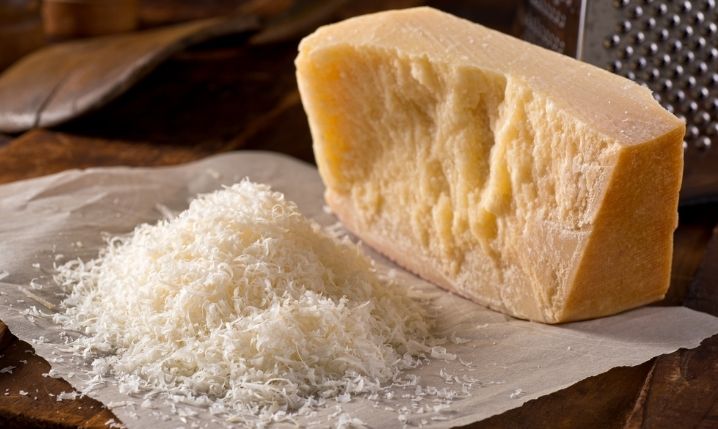Italian cheese is often confusing because of the huge range of types and varieties. This article will explain everything you need to know about the distinctions and differences between pecorino and parmesan cheese. Read on to find out all you need to know between pecorino vs. parmesan.
Contents:
What Is Pecorino?

Pecorino is a variety of Italian cheese, and it’s also a family of cheeses. One of the most famous pecorino cheeses is called pecorino romano.
One of the main things you need to know about pecorino is that it’s made from sheep’s milk.
It’s a type of hard cheese with a creamy, crumbly texture. It tastes buttery, mild, and nutty. Some varieties, such as pecorino romano, are sharp and salty. Pecorino cheeses have a pale yellow color that looks lighter when grated.
Pecorino is produced in Sardinia, Italy. It also has a history and remains popular in Lazio and Tuscany.
It’s typically aged for a minimum of at least five months.
You can use pecorino cheese to sprinkle over pasta dishes, sauces, soups, adding slices into salads, and more.
What Is Parmesan?

Parmesan is another variety of Italian cheese, like pecorino. It’s also a family of cheeses. One of the most famous types of parmesan is called parmigiano reggiano, often simply known as parmesan.
Parmesan is produced in Parma, Reggio Emilia, Modena, Bologna, and Mantua, Italy. It’s made from unpasteurized cow’s milk.
The texture is dense and grainy because it’s a hard cheese, which makes parmesan an excellent cheese for grating and sprinkling over pasta dishes, sauces, soups, and more. It’s often sold pre-grated as that is the most popular use for parmesan cheese.
It has a straw color that sometimes looks a light yellow in appearance. In most cases, Parmesan is aged for a minimum of 24 months, but it can also be aged a lot longer.
The flavor profile is fruity, nutty, sharp, and savory, and it also has a slight saltiness to the overall taste.
What’s The Difference Between Pecorino and Parmesan?
| Pecorino | Parmesan |
|---|---|
| Pecorino family | Parmesan family |
| Hard cheese | Hard cheese |
| Made from pasteurized or unpasteurized sheep’s milk | Made from unpasteurized cow’s milk |
| Comes from Italy | Comes from Italy |
| Buttery, nutty, salty, sharp. | Fruity, nutty, savory, sharp, mildly salty. |
The primary difference between pecorino and parmesan cheese is that pecorino is made from sheep’s milk, and parmesan is made from cow’s milk.
The difference in how these cheeses are made does affect the final flavor, with cheeses in the pecorino family being buttery to salty but generally always sharp-mildly sharp. Parmesan has a more robust taste that can sometimes be described as ‘savory.’
Pecorino is aged for a minimum of five months, but parmesan, especially parmigiano reggiano, is aged for at least 24 months.
They can both be used in similar situations, and both work as great substitutes for one another because they’re both hard cheeses from Italy.
- Type: The pecorino and parmesan cheese families are both types of hard cheese.
- Appearance: Pecorino is a pale yellow in appearance, while the color of parmesan is better described as straw-like. You can purchase both pre-grated or whole in varying sizes and shapes.
- Taste and texture: As they’re both types of hard cheese, the texture of pecorino and parmesan is crumbly and flaky. The flavor of these cheeses varies, even among their own families, with some types of pecorino being saltier than others. Parmesan is almost always savory, nutty, and mildly salty tasting.
- Culinary uses: Both pecorino cheese and parmesan work well in pasta dishes and sauces. They are often added to non-Italian dishes like mashed potatoes and more.
Conclusion
Now you know everything you need to know when comparing pecorino vs. parmesan. Pecorino cheese is a type of hard Italian cheese with a sharp-salty taste, whereas parmesan is more savory and nutty. The two important differences between the two kinds of cheese are that they come from different types of milk, and they’re aged for varying amounts of time. Despite being different in a few key ways, they’re also great substitutes for one another as they’re typically used in the same dishes.